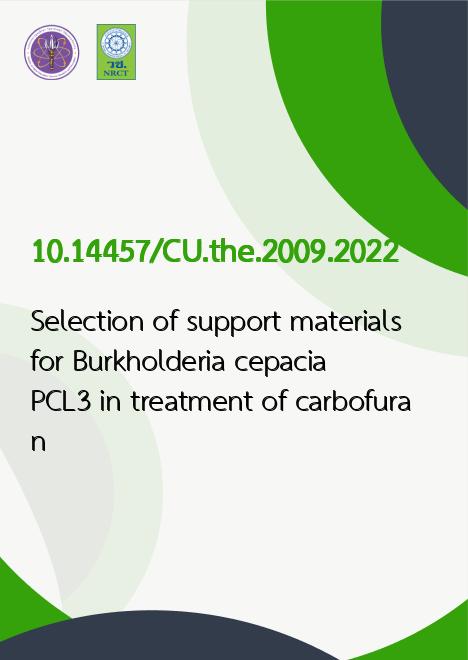
|
Selection of support materials for Burkholderia cepacia PCL3 in treatment of carbofuran |
|---|---|
| รหัสดีโอไอ | |
| Title | Selection of support materials for Burkholderia cepacia PCL3 in treatment of carbofuran |
| Creator | Sucheera Laocharoen |
| Contributor | Alissara Reungsang |
| Publisher | Chulalongkorn University |
| Publication Year | 2552 |
| Keyword | Carbofuran, Bioremediation, Immobilized cells, Sewage -- Purification -- Biological treatment |
| Abstract | Four types of agricultural residue i.e., coir, bulrush, banana stem and water hyacinth stem in delignified and undelignified forms were used as support materials for the immobilization of Burkholderia cepacia PCL3 in carbofuran remediation. The bioremediation experiments were conducted at the initial carbofuran concentration of 5 mg l-1 in synthetic wastewater (SWW) and 5 mg kg[superscript -1] in soil. Results indicated that undelignified coir was the most suitable support material for PCL3 immobilization in carbofuran remediation in SWW and soil. In SWW, the immobilized cell on coir possessed a high stability of 78.72%, high carbofuran degradation ability with the short t[subscript 1/2] of 3.40 days (2.8 times shorter than the treatments with free cells of PCL3). In addition, it could be reused at least three times with the remaining of high carbofuran degradation ability (t[subscript 1/2] of 2.58-4.41 days). In soil, immobilized PCL3 on undelignified coir gave the high carbofuran degradation efficiency with the short t1/2 of 18.96 days and showed a potential to be reused with the short t[subscript 1/2] of 20.06 days. The effect of initial carbofuran concentration on growth and carbofuran degradation ability of immobilized PCL3 on coir in comparison to free cells was investigated in SWW and soil with the concentrations ranged between 5 and 250 mg l[superscript -1] and 5 and 250 mg kg-1 soil, respectively. In SWW, the growth and degradation ability of free cells were inhibited at the initial carbofuran concentrations of greater than 100 mg l-1. The inhibitory effect of carbofuran on PCL3 could not be found in the immobilization treatments. In soil, the growth of free cells was inhibited at the concentration of greater than 100 mg kg[superscript -1] while the growth of the immobilized cells was not inhibited in any range of carbofuran concentration. Substrate inhibition model, Loung model, was used to explain the growth and degradation kinetic of PCL3 in free cell form while the Monod model was used to predict the kinetic behavior of the immobilized cells. The results indicated that the concentration of carbofuran of approximately 250 mg l[superscript -1] could completely inhibit growth and degradation activity of free cells of PCL3 in SWW and the carbofuran concentration of approximately 284 mg kg-1 could completely inhibit growth of PCL3 in soil. The smaller mumax and K[subscript s] values were obtained when the immobilized cells were used as compared to free cells. At the initial carbofuran concentration of 1-150 mg kg-1 soil, the carbofuran degradation efficiency of PCL3 in free and immobilized cell forms was not significant different. However, at the high carbofuran concentrations of 200-250 mg kg-1 soil, the t1/2 of carbofuran in soil augmented with immobilized PCL3 were approximately 1.5 times shorter than in the treatments with free cells. The results indicated a great potential of using immobilization technique to improve the overall efficiency of carbofuran bioremediation in water and soil by B. cepacia PCL3. |
| URL Website | cuir.car.chula.ac.th |